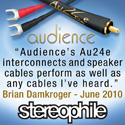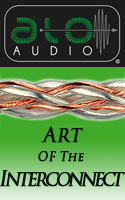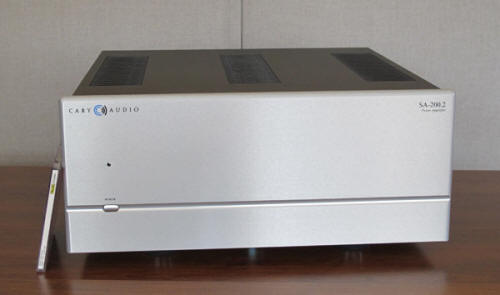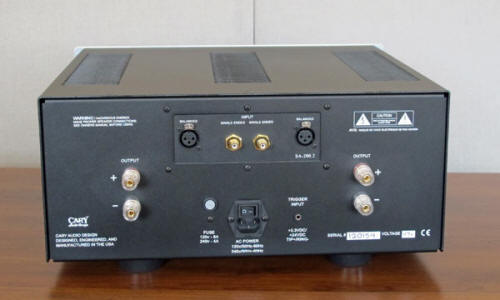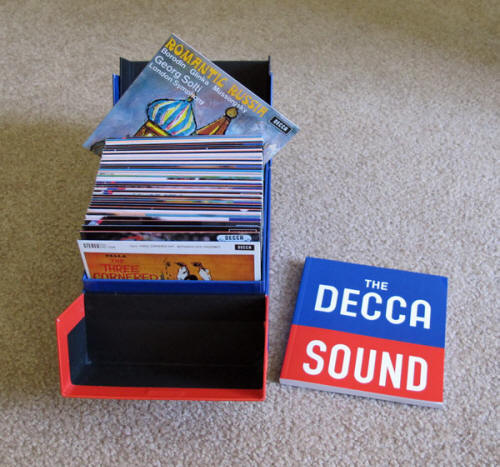|
|
You are reading the older HTML site
Positive Feedback ISSUE 61
cary audio 200.2 Stereo Amplifier as reviewed by Kent Johnson
One of the primary motivations for doing audio reviewing is that you get to hear a piece of interesting equipment in your own system, and in your own room, without having to buy it first. Even where listeners have access to actual stores from which they can borrow equipment, they still may not get this sort of opportunity. And even if they do, the sort of time frame a reviewer gets to spend listening will never be available. Doing reviews often comes with surprising results. You learn things about your system that you never suspected, and you often find yourself reconsidering your own opinions, expectations, and prejudices. I am repeating myself here, but, as an example, I thought I was getting pretty much all the bass performance that my Magneplanar MG1.6 speakers were capable of prior to reviewing the Class D Wyred4Sound STI-500 integrated amplifier. It was shocking to discover that the 1.6s had considerably more, and better bass capability than I had ever suspected. See PFO Issue 48 for that review. About a year ago, due to the closing of a local dealer's second store, I had the opportunity to purchase a McIntosh MA6300 integrated amp at a very good price—not far above cost, I believe. At the time, I thought that the way I wanted to go with my system was to downsize from a preamp/amp combination to an integrated. I love owning the McIntosh. I love the way it sounds. I love looking into its big blue power meters. It has become clear, however, thanks to comparisons with other equipment that I have had the opportunity to review, such as the Quad QSP amplifier in Issue 59, that the Mac and my current MG1.7 speakers are not an ideal couple. They are really good but the MA6300 cannot produce the sort of bass that I have found the 1.7s capable of developing. On paper the MA6300 should be fine, but in reality it does not perform as well with the 1.7s as it did with the 1.6s that I had when I bought it. I think part of the reason may be that I am actually listening somewhat louder to the 1.7s, and this increase in volume is making greater demands on the amplifier section. I have been searching for a solid state amp that would provide the same quality of sound as the McIntosh, but with a bit more grunt. I am open to the idea of another more powerful integrated, but I suspect that I will return to a preamp/amp combination. The one thing I want to do in either eventuality is have the capability of running a fully balanced system. In researching the myriad preamp/amp possibilities, I found the Cary Audio Design SPL-03 tube preamplifier and new 200.2 stereo amplifier. These two components looked like pretty much exactly what I had in mind. I contacted Cary about getting this pairing for review. Between the time I queried Cary, and heard back, I chanced upon a used SPL-03 on Audiogon. It was reasonably priced and came with a set of low-hour NOS JAN Mullard CV4003/12AU7 tubes. The Cary Audio Design SPL-03 was reviewed by Robert Levi in PFO in Issue 33. After reading his very favorable review, I decided to purchase the preamp. One of the things that Robert suggested in his review was installing a set of NOS tubes in the SPL-03. He felt this upgraded the performance a worthwhile amount. Since this preamp had that already done, I did several other upgrades that I felt were also worthwhile. I put a pair of silicon tube dampers on each tube, locating them where the internal spacer meets the glass. I also replaced the two internal fuses with their Hi-Fi Tuning Supreme equivalents. I made up some shorting plugs for the unused inputs, and put a Gutwire Notepad2 over each of the power transformers at the front of the Cary. (The SPL-03 is an entirely duo-mono layout except for the power cord.) The Notepad2s are designed to stop stray EMF radiating from a component while providing some useful damping of the chassis. As Robert noted, damping the chassis isn't really necessary with the SPL-03. The casework is very heavy duty. I listened to the SPL-03 with the amp section of my Wyred4Sound STI-500 integrated amp initially and got great results. As excellent as the MA 6300 is, there is an ineffable quality associated with a tube front end. There is rightness to the sound that exposes the descriptive limitations of the available audio language. The terms we use: frequency response, soundstaging, bass, treble, midrange, smoothness, detail, impact, dynamics, extension, and so forth, just don't get to the heart of what sounds so right about tubes. The inclusion of classically musical terms, and even the description of emotional responses, only help to get closer. Tubes simply sound more like music. And, in the SPL-03, they also do it without any tradeoffs. Through the W4S amp, there was no noise of any kind present at the speakers. The expectation that tubes will unavoidably inject some hum and hiss simply is not the case with the Cary preamp. There is also no sense of them imposing any limitations—bass was seismic and highs were only limited by the recordings. Vocals, the heart of the midrange, truly came to life. I heard back from Cary shortly after my preamp purchase, saying that they would be happy to have me do a review of the 200.2. Cary makes both the stereo 200.2 and the monoblock 500.1 amplifiers utilizing the same chassis. The 200.2 stereo amp is rated at 200 Watts per channel into 8 Ohms and 350 into 4 Ohms. The monoblock 500.1s output 500 Watts into 8 Ohms and an extraordinary 1 Kilowatt into 4 Ohms. Both are class AB amplifiers. Having become a power junkie over the past few years, I was really tempted to ask for a pair of the 500.1s. Cost, regrettably, was the determining factor. The 200.2 sells for $4000 (reasonable in the context of my system); a pair of the 500.1s is $10,000(perhaps somewhat extravagant). All of my listening to the 200.2 amplifier was done in combination with the SLP-03 preamplifier using Supra Sword balanced interconnect cables. I used a stereo pair of Zentara Reference 2 speaker cables with my Magneplanar MG1.7 speakers. The source component was my McIntosh MVP-871 universal player. Description It only took a few days for the Cary 200.2 amplifier to arrive. It is heavy, weighing 65 pounds. Much of this weight is due to its very large 1500 VA power transformer and 82,000 µF of capacitance. There isn't much to describe about the Cary's appearance that isn't immediately self-evident. It is large, measuring approximately 18 inches wide by 8 inches high by 18 inches deep including the rear binding posts. The front fascia is 10mm thick and features a stand-by switch and blue led that comes on when the amp is powered up. "Design" and "Statement" aren't the first words that come to mind when looking at the 200.2. It is nice looking, very well made, and purposeful while conveying a tacit message that Cary is spending its customer's money on the insides and not on decoration.
On its rear panel the Cary amp offers very good quality speaker binding posts, and a pair each of single-ended RCA and balanced XLR inputs. There is an IEC AC receptacle and a main power switch. The Cary 200.2 arrived with about 36 hours of break-in time on it. Cary recommends 100 hours or so of break-in, so I put another 36 on it running both music and the Isotek "Full System Enhancer & Rejuvenation Disc." I definitely think this CD speeds up break-in and tunes the system up. Listening I did some casual listening until I reached about 80 hours of use. At this point, I felt that there was a noticeable improvement in low level detail. There was decidedly more air around the soundstage, accompanying voices, and exiting wind instruments. I began listening more critically. I recently purchased Brad Mehldau's new CD, Ode (Nonesuch 529689-2). It features Brad as pianist/composer, Larry Grenadier on bass, and Jeff Ballard on drums. It is a musically varied and interesting performance. It has an "immediate" sonic signature that brings the trio right into the listening space. I happened to follow Ode with Opening by Mathias Landaeus (M·A recordings M081A). It is equally varied musically, and also very good sounding (as are all the M·A recordings). This CD features Mathias as pianist/composer, with Palle Danielsson on bass, and Jon Fält on drums. I found comparing these two jazz trios through the Cary system very interesting and revealing.Both are audiophile quality but both differ in the way they emphasize various aspects of each recording. Both recordings place the piano toward the front right of the soundstage. Both place the drums at the rear center. The bass on Ode is also in the center but close to the front of the soundstage. The bass on Opening is at the left front. The perspective on Ode is very close. The instruments on Opening sound farther from the microphones or as if they are in a larger space. Both pianos sound very clear, detailed, and transparent. All the nuances of their performance are easy to follow and appreciate. The drums on Ode are big, extremely big. They spread like a tidal wave from the rear of the soundstage, overwhelming everything including the other two instruments. When the drums go loud, they move further forward in the soundstage than sounds realistic or accurate to me. To be blunt, they become very intrusive. The acoustic bass on Ode is bigger, louder, more dynamic, and visceral than is completely realistic as well. The difference is that the bass stays where it belongs. The drum set on Opening never jumps around, which I like very much. It still has impact and a lot of detail. The bass, however, is too reticent for my tastes. I want to reach out and turn it up so it plays a larger part in the performance, so it develops some authority. Neither recording is exactly what I would ideally like to hear. Less prominent drums on Ode, more prominent bass on Opening and my sonic tastes would be better satisfied. What I absolutely do want, and do not want to live without, is what the Cary 200.2 does while reproducing these discs—presenting exactly what is on each recording without alteration, exaggeration, or editorializing. The way in which these two performances are reproduced makes it manifestly clear that the Cary is staying resolutely impartial. Good or bad, like or dislike the music or performance, this is what I want from an audio system. There would be little point in having the 200.2's power output if it wasn't put to use. Cirque de Soleil's Viva Elvis, The Album (RCA/Legacy 88697 77582 2) gave the Cary amp a chance to show the MG 1.7s who was in charge. This CD is big, loud, and propulsive. Yet it also manages delicacy and fine detail. The small snippets of sound interwoven into the overall performance are not obscured; they are there to be discovered. The Cary gets everything that is on the disc into the speakers. The impact and quality of the bass is really fairly astounding, considering the MG1.7s reputation for being bass light. Most of the songs are from Elvis's early years, and remind the listener that this guy had a great voice. Probably only Sinatra's voice was more capable of revealing finer nuances and shadings in the performance of a song. It makes you wish Elvis's life hadn't gone so terribly wrong. What could he have done with some first class material instead of the schlock he typically sang? The Cary gets the voice absolutely right—a voice that despite the entire distracting spectacle surrounding it, still draws your entire attention to it. Sonically, this is a spectacular recording in the best sense of the word. I ran the 200.2 pretty hard while playing this disc, so I checked its top cover right over the internal heat sinks when I changed CDs. It was just a bit above mildly warm. Despite all the energy demanded by Viva Elvis, the Cary did not seem to have even broken a sweat. Tim Allen is right—the answer is always, "More Power." It has been a while since I listened to Shelby Lynne's Just a Little Lovin' (Lost Highway B0009789-02). The room reverberation on "You Don't have to Say You Love Me" has been useful in determining how well a component does low level detail. With the 200.2, the recording felt more realistically sized than I have heard before if a little less spectacularly expansive as a result. In that sense, the improvement in the accuracy of the sound was a bit of a trade-off. (I really like big reverb.) Where there was no trade-off, only improvement, was in the reproduction of her voice. It was crystalline in its clarity. Shelby sang against an utterly silent background via the Cary equipment, and every nuance of her voice was conveyed with terrific integrity. This voice, against the spare arrangements, becomes amazingly effective at conveying a significant emotional scale. I really don't imagine that many of the composers of the songs on this CD ever expected them to sound quite the way Shelby performs them. Getting the female voice to sound as real as possible is the second most important quality that I look for in any audio component, right after soundstaging. The 200.2 amplifier does female voice superbly. I listened to quite a few piano recordings, mostly jazz, in the course of this review. The performers included Dave Brubeck, Oscar Peterson, Andre Previn, Kenny Barron, Duke Ellington, Marcus Roberts, and Keith Jarrett. I found a copy of Jarrett's The Melody at Night with You (ECM 1675) at a garage sale. Being unfamiliar with the recording, I nearly jumped straight out of my chair when, out of nowhere, he started to hum along. I know he does this but I was completely unprepared for how real and how unexpectedly the voice emerged from my right speaker! ECM should provide a warning label. In any case, all of these recordings sounded, to my ears, like real pianos, allowing for the age and quality of the recording. There was weight to the lower registers, a realistic harmonic envelope surrounding each note, and a really lovely decay to silence as the strings lost energy. The piano's position in the soundstage made sense as well within the context of the recording. It is frequently said that the piano is a difficult instrument to record but you would not know that listening to the 200.2. The exception was possibly Gonzalo Rubalcaba's piano on his CD, Solo (Blue Note 0946 3 31260-2). On this recording, the low notes appeared in the right speaker, and the high notes in the left, with the rest of the notes appearing across the soundstage. This alone seemed odd, sort of backwards, but when a low note was offset by a high note, and they appeared only at the extreme edges of the soundstage, it just seemed bizarre. Also disconcerting was my inability, as a listener, to figure out just how the piano was oriented in relation to my listening position. It became clear that the only position that seemed possible, based on the sound, was facing the pianist down the length of the piano. Who listens from that location? Fortunately, musically, this recording still had a lot to offer. The music was very interesting and extremely well played. The problem was getting my brain to stop trying to figure out what direction the piano was pointing and just enjoy it. When you live by the soundstage, sometimes you die by the soundstage. And then you play something that truly is to die for. Patricia Barber's Nightclub was that recording. (Koch KOC-CD-5738). Playing this CD via the Cary SPL-03/200.2 combination was so convincingly real, so utterly believable, that all I could do was sit and listen. This sort of recording is why you aspire to the best system you can possibly afford; why you want to drag family, friends, even perfect strangers into your listening room and say, "You have to hear this!" Listening to this CD was an amazing experience.
The April 2012 issue of the Absolute Sound had an article by Ted Libbey on a 50 CD retrospective boxed set called The Decca Sound. This set is an overview of Decca classical recordings; the earliest of which dates from 1956, the most recent from 2009. The set looked so interesting that I spent some time on the Internet looking for one to purchase. (I did check the local Barnes & Noble stores, the only retail music outlet left where I live, to see if they carried it. None did.) The TAS article states that the set sells for $2 per disc. I did not find that to be the case. My research indicated that the list price of the set is around $169. Still, I was able to find a sealed set on Amazon for $126, delivered. Certainly a very good deal for 50 CDs. The set includes a booklet with details on all of the included performances. It lists the main performers, recording dates and venues, producers and engineers, the original LP numbers, the total time and, in most cases the published source of the music. There are also a fair number of photos. The booklet also includes a history of Decca and information on the recording techniques used to create what has become known as "The Decca Sound." Fifty CDs are, at best, only an hors d'oeurve to the feast that is fifty years of recording. The repertoire chosen is, overall, fairly familiar, with no really obscure compositions. At the same time, it also avoids the inclusion of the traditional warhorses. There is no Beethoven's Fifth, but there are some late Beethoven string quartets and his septet, some piano sonatas, and the Violin Concerto. Dvorak's Ninth is the only ninth present. No 1812 Overture either, but Tchaikovsky is represented by his Serenade for Strings and Souvenir of Florence. Instead of some Haydn string quartets—the set's only oversight in my opinion and for which I would readily trade Ravel's Bolero—we get some vocal music in the form of his Nelson Mass and the Mass in C Major. There is also a good amount of opera included. The only Mozart I can find are some piano concertos and an opera scene. Bach is represented by his Magnificat in D Major, two cantatas, and Andres Schiff playing the Goldberg Variations. There is, of course, much much more. A slice it may be, but it is still a lot of music to sort through. I found a number of compositions that I don't have, and some nice alternatives to those I do have. I began listening with CD 4, Vladimir Ashkenazy orchestrating and conducting Mussorgsky's Pictures at an Exhibition with the Philharmonia Orchestra from 1982. I thought the performance was absolutely gorgeous. This is extremely dynamic music, and the recording captures that remarkably well, with big crescendos alternating with delicate solos. The Cary 200.2 did a superb job with this disc. The sound never exhibited any sense of congestion or compression but was remarkably open and effortless. It was also spacious. The MG1.7s effectively disappeared into the extensive soundstage that appropriated the end of my listening room. The music rose and fell around the 1.7s, and rarely every sounded as if it was located within them. The Cary 200.2 provided the sound with scale—scale in the sense that this performance was being reproduced as large and realistically as the speaker's limitations and room would permit. To get a larger sound, even better scale, would necessitate larger speakers in a larger room. The performance was extremely satisfying and physically tangible. It may be trite, but characterizing the 200.2 as a steel fist in a velvet glove is not easy to improve upon. I jumped to CD 44, Romantic Russia, music of Borodin, Glinka, and Mussorgsky performed by the London Symphony with Sir George Solti conducting (1966). This, too, is blockbuster stuff with the Ruslan and Lyudmila Overture, Night on the Bare Mountain, and Polovtsian Dances, as part of the program. These pieces were played loud and fast, but with remarkable clarity and precision. Detail was never sacrificed for speed, or lost in an unrelenting cascade of notes. The Cary 200.2 always had the situation under control, but the overall sonic limitations were always those of the recording. Musically and sonically, The Decca Sound is extremely easy to recommend. Conclusion As I noted at the beginning of this article, unexpected discoveries are often made in the course of a review. The Cary 200.2 unveiled a soundstage with more realistic openness and space than I have previously heard. I believe that reproducing sound of this quality requires a system to have superb timing with equally good low level detail retrieval. The Cary made this seem easy. The Cary 200.2 has tremendous bass power with an attendant level of bass definition. The SPL-03 preamp/Wyred4Sound STI-500 combination, by comparison, showed itself to be just a nudge less well defined, and less well controlled. Overall, the Cary is a more sophisticated amplifier (with a commensurately higher price as well). The human voice is reproduced with marvelous fidelity via the 200.2, whether it is a solo from Patricia Barber, or the chorus of the Polovtsian Dances. It would have been easy to listen to female vocals and nothing else during the time I have had the 200.2. The Cary amp reproduced cymbals with more shimmer and life than I have heard via CD at any time previously. Woodwinds were gorgeous. String tone was lovely and entirely recording dependent. Even then, when the tone was somewhat steely and upfront as it was on Respighi's Ancient Airs and Dances, a 1958 stereo recording by Antal Dorati and the Philharmonia Hungarica, it was never over-emphasized. The Cary let me know that it was an older recording and that fact never overshadowed the music itself. The most succinct description that I can offer of the Cary's sonic and musical abilities would be to say that it is the musical equivalent of baby bear's porridge. It is just right. The Cary Audio Design 200.2 amplifier never is too much, or too little of anything. The loudest crescendo isn't exaggerated; the softest caress of a piano key isn't diminished. Feed it an exceptional recording and you get stunning realism in return; feed it a lesser recording and you still can appreciate its musical strengths. I think I have found the amplifier that I have been looking for. Kent Johnson
200.2
Stereo Amplifier
Cary Audio
|
